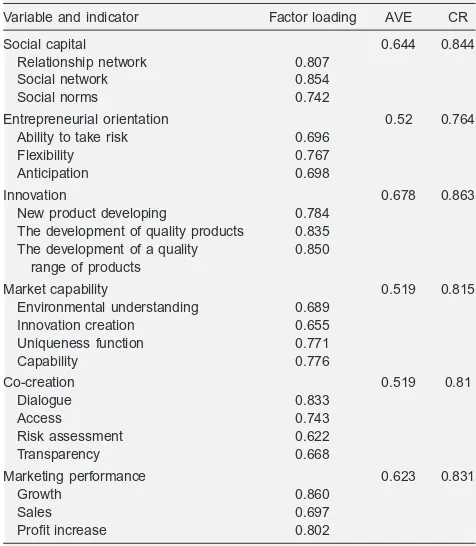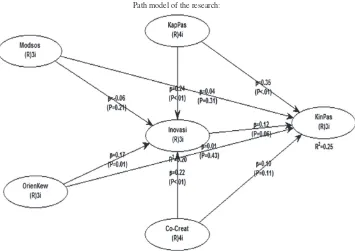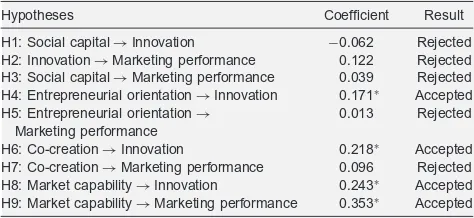Delivered by Ingenta to: Bulan Prabawani
IP: 120.188.67.137 On: Tue, 04 Apr 2017 08:15:18
Copyright: American Scientific Publishers
Copyright © 2017 American Scientific Publishers All rights reserved
Printed in the United States of America
R E S E A R C H A R T I C L E
Advanced Science Letters
Vol. 23, 471–474, 2017
Antecedent of Innovation and Marketing
Performance in Batik Industry
Naili Farida
Faculty of Social Sciences, Diponegoro University, Jl. Prof. Sudarto, SH., No. 1 Tembalang, Semarang, Central Java, Indonesia
Batik is one of the important industries and the pride of Indonesia. Batik is a world cultural heritage which is originally Indonesia. In batik industry, innovation is one of the important factors that will improve marketing performance. This study wanted to test some of the main drivers of innovation and marketing performance on Batik SMEs. The purpose of this study is (1) Testing the influence of social capital on innovation and marketing performance; (2) Testing the effect of entrepreneurial orientation on innovation and marketing performance; and (3) Testing the influence of co-creation on innovation and marketing performance. The research sample consisted of 161 batik businesses in the city of Sragen and Purwodadi. Data were analyzed using SEM PLS and processed using WarpPls with version 5. The results of this study indicate that only some of the hypotheses are accepted, such as (1) entrepreneurial orientation is able to significantly improve innovation, (2) co-creation is able to significantly increase innovation, (3) market capability is able to significantly improve innovation, and (4) market capability is able to significantly improve marketing performance.
Keywords: Entrepreneurial Orientation, Social Capital, Market Capabilities, Co-Creation, Innovation, Marketing Performance.
1. INTRODUCTION
Batik is one of the important industries in Indonesia1and a pride for Indonesia.2Batik is a product that is recognized by UNESCO as a cultural heritage of Indonesia.3 Originally batik was just as the art of dyeing cloth and focused on the use of motifs, but in its development, batik is considered as one of the flagship product. In Indonesia, batik is well developed in several areas, such as Solo, Sragen, Pekalongan, Lasem, and several cities in Java.
Innovation becomes an important part in the SMEs,4 partic-ularly Batik SMEs. The innovation in batik industry can be in the form of batik motif development. Initially, batik motifs are mostly animals and plants. But in its development, the motif is modified into a variety of models showing that batik is a modern product. Innovations done by a business will be able to improve its performance,5–9 and this is also true for Batik SMEs.1 Some Batik SMEs produced only by firm order while some others made production and innovation incrementally. Thus, it can be said that the existing problems in SMEs Batik in Sragen and Pur-wodadi is that product innovation and marketing performance is not maximal.
The focus of this research is some antecedents of innova-tion and marketing performances. There are some variables that become the antecedent of innovation and marketing perfor-mances, they are: (1) entrepreneurial orientation, (2) social capi-tal, and (3) co-creation.
The purposes of this research are:
1. To test the influence of social capital on innovation and mar-keting performance.
2. To test the influence of entrepreneurial orientation on innova-tion and marketing performance.
3. To test the influence of co-creation on innovation and mar-keting performance.
2. LITERATURE REVIEW AND HYPOTHESES
Social capital is synonymous with networks of social relations. From the standpoint of Woolcock,10 social capital is defined as information, trust and norms inherent in social networking. Lin11 defines social capital as a resource that is embedded in social net-works accessed and used by the actors to perform certain actions. Social capital is more focused on individual characteristics in relation to social interaction they do. It is important to improve innovation12and performance.113Innovation means creating new product and offering it into the market. Companies that are innovating will attempt to get their product always needed by the markets, although it is a new product. Some studies suggest that innovation done by a company is able to improve the performance of the company.5–9
Entrepreneurial orientation (EO) of a company is defined as a company involved in technology innovation, doing risky business, and pursuing proactive opportunities.14Entrepreneurial orientation will be able to increase success in innovation.5 Besides affecting innovation, entrepreneurial orientation is also able to improve performance. Matsuno, Mentzer15 shows that entrepreneurial orientation can improve performance.
Delivered by Ingenta to: Bulan Prabawani
IP: 120.188.67.137 On: Tue, 04 Apr 2017 08:15:18
Copyright: American Scientific Publishers
R E S E A R C H
A R T I C L E
Adv. Sci. Lett. 23, 471–474, 2017Li, Huang16 examines how entrepreneurial orientation influences working performance in entrepreneurships in Taiwan. Soininen, Martikainen17studied the influence of entrepreneurial orientation on performance (growth and profitability). The results of both16 and17 is positive and significant.
Joint creation is a joint participation between consumers and producers to create value in the marketplace.18 Con-ducting a joint creation between companies and consumers will also be able to improve much innovation and marketing performance.1920 One of the dimensions of joint creation (shar-ing knowledge and experience) can improve innovation and per-formance significantly.2122
From the above explanation, the hypotheses in this study are: H1: Social capital can significantly improve innovation. H2: Innovation can significantly improve marketing performance.
H3: Social capital can significantly improve marketing performance.
H4: Entrepreneurial orientation can significantly improve innovation.
H5: Entrepreneurial orientation can significantly improve mar-keting performance.
H6: Co-creation can significantly improve innovation.
H7: Co-creation can significantly improve marketing performance.
H8: Market capabilities can significantly improve innovation. H9: Market capabilities can significantly improve marketing performance.
3. RESEARCH METHODOLOGY
The population in this study was 525 batik business in the city of Sragen and Purwodadi. Sampling technique is purposive sam-pling, with criteria, as follows:
(1) the age of Batik SMEs is at least 5 years, (2) having network with other companies, and (3) having at least 10 employees.
Questionnaires were distributed to all owners of SMEs Batik, but the questionnaires given back and can be processed again is as much as 161 respondents. So the study sample was 161 batik SMEs in Sragen and Purwodadi.
Data analysis in this study used Structural Equation Model-ing (SEM), in particular the SEM-PLS. SEM-PLS Model was divided into two types: the measurement model (examine the relationship between observed and latent variables) and the struc-tural model (examine the relationship between the latent variables with latent). To process the data obtained, this study uses Warp-PLS version 5.
4. RESEARCH RESULTS
4.1. Result of Measurement Model
Reliability and validity were used to test whether the research instrument developed has been reliable or valid. In this study, reliability measurement used Composite Reliability while valid-ity measurement used Convergent Validvalid-ity and Average Vari-ance Extracted. The requirement for Composite Reliability is that the value should be above 0.60; the requirement for Conver-gent Validity is that the Loading Factor value should be above 0.50; and the requirement for AVE is that the value should be
Table I. Factor loading, AVE, and composite reliability.
Variable and indicator Factor loading AVE CR Social capital 0.644 0.844
Relationship network 0.807 Social network 0.854 Social norms 0.742
Entrepreneurial orientation 0.52 0.764 Ability to take risk 0.696
Flexibility 0.767 Anticipation 0.698
Innovation 0.678 0.863 New product developing 0.784
The development of quality products 0.835 The development of a quality 0.850
range of products
above 0.50. From Table I, it can be concluded that the research instrument used in this study has been reliable and valid. This is because the value of Composite Reliability, Convergent Validity and AVE have already been above the required value.
4.2. Result of Structural Model
Model fit is an evaluation of whether the data is matched with the empirical model developed in this study. Several types of model fit used in this study are Average Path Coefficient (APC), AverageR-Squared (ARS), Average AdjustedR-Square (Aars), Average Block VIF (AVIF), Average Full collinearity VIF (AFVIF), Sympson’s Paradox Ratio (SPR), R-Squared Contri-bution Ratio (RSCR), Statistical Suppression Ratio (SSR), and Nonlinear Bivariate Casuality Direction Ratio (NLBCDR). From the Figure 1 below, it can be concluded that the data are in accor-dance with the model developed for all model fit measurements have been in conformity with the requirements.
Hypothesis 1 tests whether social capital has a positive and sig-nificant influence on innovation. The results of this study indicate that social capital has a negative but not significant influence on innovation (B= −0062;p >005). Hypothesis 1 was rejected. The results of this study differ from previous studies.12
Hypothesis 2 tests whether innovation has a positive and sig-nificant impact on marketing performance. The results of this study indicate that innovation has a positive but not significant effect on marketing performance (B=0122,p >005). Hypoth-esis 2 was rejected. These results differ from previous research, which explains that innovation has a positive and significant impact on marketing performance.5–723
Hypothesis 3 tests whether social capital has a positive and significant impact on marketing performance. The results of this study indicate that social capital has a positive but not significant
Delivered by Ingenta to: Bulan Prabawani
IP: 120.188.67.137 On: Tue, 04 Apr 2017 08:15:18
Copyright: American Scientific Publishers
R E S E A R C H
A R T I C L E
Adv. Sci. Lett. 23, 471–474, 2017
Path model of the research:
Fig. 1. Path model.
effect on marketing performance (B=0039;p >005). Hypoth-esis 3 is rejected. The results of this study differs from previous research saying that social capital has a positive and significant impact on marketing performance.24 There are two conditions that possibly make the influence of social capital on marketing performance not significant. First, individualism in this industry is still quite thick. They may have a network, but the network is not used to improve business performance. The tendency of individualism in running a business get them to consider other business as the main competitor so that the networks created are not able to improve its business performance. Second, the absence of a mature system in making social networking.
Hypothesis 4 tests whether entrepreneurial orientation has a positive and significant impact on innovation. The results of this study indicate that entrepreneurial orientation has a positive and significant impact on innovation (B=0171;p <005). Hypoth-esis 4 is accepted. These results are similar to previous studies.5 Hypothesis 5 tests whether entrepreneurial orientation has a positive and significant impact on performance marketing. The results of this study indicate that entrepreneurial orienta-tion has a positive but not significant effect on marketing per-formance (B=0013;p >005). Hypothesis 5 is rejected. These
Table II. Results of goodness of fit.
Model fit Requirement Result Note
Average path coefficient (APC) P <005 APC=0,146;p=0.015 Model has been fit
AverageR-squared (ARS) P <005 ARS=0.229;p <0001 Model has been fit Average adjustedR-square (AARS) P <005 AARS=0.207;p <0001 Model has been fit
Average block VIF (AVIF) AVIF<3.3 1.672 Model has been fit Average full collinearity VIF (AFVIF) AVIF<3.3 1.527 Model has been fit Sympson’s paradox ratio (SPR) SPR>0.7 0.889 Model has been fit
R-squared contribution ratio (RSCR) RSCR>0.9 0.970 Model has been fit Statistical suppression ratio (SSR) SSR>0.7 1.000 Model has been fit Nonlinear bivariate casuality direction ratio (NLBCDR) NLBCDR>0.7 0.722 Model has been fit
results are in contrast with previous studies.15–1725 There are some researches explaining that entrepreneurial orientation has no significant effect on performance.2627
Hypothesis 6 tests whether co-creation has a positive and sig-nificant impact on innovation. The results of this study indicate that co-creation has a positive and significant impact on inno-vation (B=0218; p <005). Hypothesis 6 is accepted. These results are in line with previous studies’.19
Hypothesis 7 tests whether co creation has a positive and sig-nificant impact on marketing performance. The results of this study indicate that co-creation has a positive but not signifi-cant effect on marketing performance (B=0096). Hypothesis 7 was rejected. These results differ from previous results, which stated that co-creation has a positive but not significant impact on marketing performance.2022 Co-creation is not a driving fac-tor increasing marketing performance. The main function of co-creation is just to boost innovation.
Hypothesis 8 tests whether market capability has a positive and significant impact on innovation. The results of this study indicate that market capability has a positive and significant influence on innovation (B=0243; p <005). Hypothesis 8 accepted.
Delivered by Ingenta to: Bulan Prabawani
IP: 120.188.67.137 On: Tue, 04 Apr 2017 08:15:18
Copyright: American Scientific Publishers
R E S E A R C H
A R T I C L E
Adv. Sci. Lett. 23, 471–474, 2017Table III. Hypotheses testing results.
Hypotheses Coefficient Result H1: Social capital→Innovation −0062 Rejected H2: Innovation→Marketing performance 0122 Rejected
H3: Social capital→Marketing performance 0039 Rejected H4: Entrepreneurial orientation→Innovation 0171∗ Accepted
H5: Entrepreneurial orientation→ 0013 Rejected Marketing performance
H6: Co-creation→Innovation 0218∗ Accepted
H7: Co-creation→Marketing performance 0096 Rejected
H8: Market capability→Innovation 0243∗ Accepted
H9: Market capability→Marketing performance 0353∗ Accepted
Note:∗Sig<0.05.
Hypothesis 9 tests whether market capability has a positive and significant effect on marketing performance. The results of this study indicate that market capability has a positive and sig-nificant effect on marketing performance (B=0243;p <005). Hypothesis 9 accepted.
5. CONCLUSION
From the 9 hypotheses constructed in this study, there are only 4 hypotheses accepted, they are, Entrepreneurship Orientation on Innovation, Co-Creation on Innovation, Market Capabilities on Innovation and Market Capability on Marketing Performance. The results of this research suggest that many antecedents of marketing performance did not able to establish marketing per-formance. This is possible because of the imprecision in selecting marketing performance, particularly in Batik industry. It is possi-ble that in batik industry, every business has unique performance, such as loyalty and customer satisfaction.
Limitations of this study are:
(1) Research was confined to small areas, namely the city of Sragen and Purwodadi, so this study can not be generalized and (2) The business of batik is not in large scale, so that the mea-surement for the marketing performance of each SMEs is possi-bly different.
This is what might make entrepreneurial orientation, co-creation, and social capital do not have a significant influence on mar-keting performance. From the two limitations of this study, it is recommended the following things for future research:
(a) analyzing innovation as an intervening variable. From the influence of social capital on marketing performance, entrepreneurial orientation on marketing performance, marketing
performance on market capabilities, and co-creation on market-ing performance, it can be concluded which one is the best inter-vening effect of the relationship of these variables;
(b) using the age and size of the business venture as a control variable;
(c) testing the empirical model on two data, the city of Sragen and Purwodadi, to know whether using one model to analyze two cities will produce the same output; and
(d) using loyalty and customer satisfaction as an indicator of performance.
References and Notes
1. E. Ardyan, G. Rahmawan, and S. Isstianto, Membangun modal sosial dan
kesuksesan berinovasi untuk meningkatkan kinerja UKM Batik, Seminar
Nasional UNIBA, Universitas Batik: Surakarta(2015).
2. R. K. Andadari, et al.,International Journal of Organization Innovation8, 156
(2016).
3. G. Budiono and V. Aryanto,Studies in Business and Economics5, 156(2010).
4. R. D. Ireland and J. W. Webb,Business Horizons50, 49(2007).
5. G. J. Avlonitis and H. E. Salavou,Journal of Business Research60, 566
(2007).
6. E. D. Eris, O. Neczan, and T. Ozmen,International Journal of Economic
Sci-ences and Applied Research5, 77(2012).
7. J. K. Han, N. Kim, and R. K. Srivastava, Journal of Marketing 62, 30
(1998).
8. S. Matear, et al.,European Journal of Marketing36, 1058(2002).
9. S. Olavarrieta and R. Friedmann,Journal of Business Research61, 623
(2008).
10. M. Woolcock,Theory and Society27, 151(1998).
11. N. Lin, Social Capital: Theory of Social Structure and Action, Cambridge
Uni-versity Press, United Kingdom(2001).
12. R. Martinez-Canas, F. J. Saez-Martinez, and P. Ruiz-Palomino,Journal of
Knowledge Management16, 61(2012).
13. X. Luo, et al.,Journal of International Marketing12, 25(2004).
14. D. Miller and P. H. Friesen,Strategic Management Journal3, 1(1982).
15. K. Matsuno, J. T. Mentzer, and A. Ozsomer,Journal of Marketing66, 18
(2002).
16. Y.-H. Li, J.-W. Huang, and M.-T. Tsai, Industrial Marketing Management
38, 440(2009).
17. J. Soininen, et al.,International Journal of Production Economics140, 614
(2012).
18. V. Swass,International Journal of Electronic Commerce15, 11(2010).
19. J.-S. Chen, H.-T. Tsou, and R. K. H. Ching,Industrial Marketing Management
40, 1331(2011).
20. H. Nysveen and P. E. Pedersen,international Journal of Market Research
56, 807(2014).
21. Z. W. Wang and N. Wang,Expert System with Application39, 3899(2012).
22. Y. Wang and J. Wu, Journal of Business to Business Marketing20, 227
(2013).
23. S. Matear, B. J. Gray, and T. Garrett,International Journal of Service Industry
Management15, 284(2004).
24. X. Luo, et al.,Journal of International Marketing12, 25(2004).
25. M. Arif, et al.,Journal of Management Reseach5, 44(2013).
26. S. Sciascia, et al.,European Management Journal32, 761(2014).
27. S. F. Slater and J. C. Narver,Journal of Business Research48, 69(2000).
Received: 1 March 2016. Accepted: 1 March 2016.


